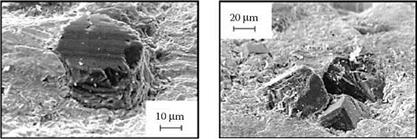A further grain wear type is microcrystalline grain splintering. This wear type is caused by microcracks resulting from mechanical and thermal tensions. These microcracks lead to a microfracture, or even to partial grain break-off.
|
|
![]()
9.3.7 Grain Break-Out
In the case of total grain break-off, whole abrasive grains are detached from the bond. The reason is a mechanical overstress of the bond due to excessive grain protrusions, as well as by excessive process temperatures. In these cases, the grain retention forces are smaller than the process forces. If a grinding wheel bond is subject to thermal overstress, especially in the case of a resin bond, the bond might soften. It is also possible for the decomposition temperature of the binding material to be reached. The grain break-off force decreases with a growing grain protrusion [Yegenoglu 1986].
9.3.8 Bond Softening
Figure 9.6 shows two grinding wheel topographies, the right one showing a cumulative grain break — off due to increasing bond softening. At constant bond wear, this leads to a deeper embedding of the abrasive grain. The result in the present case is a decreasing number of cutting edges and increased stress on the surrounding grains. If bond wear increases due to bond softening, this leads to increased radial wear of the wheel.
Figure 9.6 also shows the parameters of the grinding wheel topography. It clearly can be seen how the groove parameters A2 and Rvk grow with increasing grain break-off.

